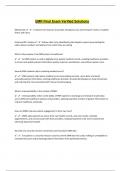EMR Final Exam Verified Solutions
EMS System ✔️✔️A network of resources to provide emergency care and transport victims of sudden
illness and injury
Enhanced 911 System ✔️✔️Allows caller to be identified by the dispatch system by providing the
callers phone numbers and address from which they are calling
What is the purpose of an EMR system in healthcare?
✔️✔️ An EMR system is used to digitally store patient medical records, enabling healthcare providers
to access and update patient information quickly, improve coordination, and enhance patient care.
How do EMR systems help in reducing medical errors?
✔️✔️ EMR systems help reduce medical errors by providing accurate, up-to-date, and easily
accessible patient information, alerting healthcare providers to potential allergies or drug interactions,
and reducing the risks associated with manual record-keeping.
What is interoperability in the context of EMR?
✔️✔️ Interoperability refers to the ability of EMR systems to exchange and interpret shared data
across different healthcare systems and providers, allowing seamless transfer of patient information to
improve healthcare continuity.
How can EMRs improve patient engagement in their own care?
✔️✔️ EMRs allow patients to access their own health records, view test results, schedule
appointments, and communicate with their providers, empowering them to be more involved and
informed about their health.
Describe one security measure commonly used to protect EMR data.
✔️✔️ Encryption is a security measure used to convert EMR data into code, making it unreadable to
unauthorized users and protecting patient information from potential breaches.
,What role does EMR play in clinical decision-making?
✔️✔️ EMRs support clinical decision-making by providing healthcare providers with access to patient
histories, lab results, and treatment plans, enabling data-driven decisions for better patient outcomes.
How do EMRs streamline the billing and coding process?
✔️✔️ EMRs simplify billing and coding by automating the process of generating billing codes and
claims based on recorded diagnoses and treatments, improving accuracy and reducing time delays.
What is the difference between an EMR and a paper record?
✔️✔️ An EMR is a digital record of a patient’s medical history, while a paper record is a traditional,
handwritten or printed document. EMRs are easier to store, search, and share, making them more
efficient and secure.
Why is data backup important in an EMR system?
✔️✔️ Data backup is essential to ensure that patient records are not lost in the event of hardware
failure, natural disasters, or cyber-attacks, allowing for continuity of care even in unforeseen
circumstances.
How does an EMR support preventive care?
✔️✔️ EMRs can track and alert healthcare providers about upcoming preventive care needs such as
vaccinations, screenings, and check-ups, helping patients stay on top of their health.
What is a patient portal, and how does it relate to EMR?
✔️✔️ A patient portal is an online platform linked to an EMR that allows patients to access their
health records, communicate with providers, and manage aspects of their care online, promoting
patient engagement and convenience.
How does EMR improve communication among healthcare providers?
✔️✔️ EMRs enable seamless sharing of patient information among healthcare providers, allowing
different members of a care team to coordinate efficiently, reduce redundant testing, and provide
cohesive care.
, What information is typically included in an EMR?
✔️✔️ An EMR typically includes a patient's medical history, diagnoses, medications, treatment plans,
immunization dates, allergies, radiology images, and laboratory test results.
Explain the role of clinical alerts in EMR systems.
✔️✔️ Clinical alerts in EMR systems notify healthcare providers of critical issues such as drug
interactions, allergies, abnormal lab results, and upcoming preventive care needs, aiding in timely
interventions.
How can EMR systems enhance healthcare reporting and analytics?
✔️✔️ EMRs facilitate healthcare reporting and analytics by aggregating patient data, allowing
healthcare providers to analyze trends, assess population health, and make informed decisions to
improve care quality.
Seven Levels of EMS training ✔️✔️1. Emergency Medical Responder (DOTrans, Basic, Advanced)
2. EMT Basic
3. AEMT (Advanced EMT)
4. Intermediate 85,99
5. EMT Paramedic
6. Critical Care Paramedic
7. TEMS (Tactical EMS)
Five Roles / Responsibilities of the EMR ✔️✔️1. Personal Health and Safety
2. Caring Attitude, Maintaining Composure
3. Neat, Clean, and Professional Appearance
4. Keep Up to Date knowledge and skills
5. Put Patients needs as a priority
Eustress ✔️✔️Good Stress




